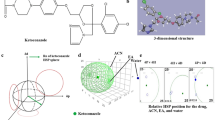Abstract
Efinaconazole is the first azole derivative approved by FDA for the topical treatment of onychomycosis. The objective of present study was to develop and validate HPLC method for estimation of efinaconazole in ex vivo human nail permeation study samples. The chromatographic analysis was performed on a HPLC system equipped with diode array detector. The efinaconazole and internal standard (IS) were extracted from the human nail samples by using the protein precipitation method. The samples were injected on to 5 μm Polar C18 100Å, 4.6 mm × 150 mm column. The mobile phase consisted of 0.01 M potassium dihydrogen phosphate: acetonitrile (36:64) and eluent was monitored at 205 nm. The chromatographic separation of drug and analyte was achieved using isocratic elution at flow rate of 1 mL/min with a total run time of 15 min. The efinaconazole and IS were eluted at 6.4 ± 0.5 and 8.3 ± 0.5 min, respectively. The developed method was validated as per FDA guidelines, and the results met with acceptance criteria. The method developed was specific, and the analyte concentrations were linear at range of 50 to 10000 ng/mL (R2 ≥ 0.9981). The validated HPLC method was applied for quantifying efinaconazole in human nail permeation study samples. The permeation of efinaconazole was increased by twofolds with Labarfac CC (15135.4 ± 2233.9 ng/cm2) compared to formulations containing Transcutol P (6892.0 ± 557.6 ng/cm2) and Labrasol (7266.1 ± 790.6 ng/cm2). The study results demonstrate that developed efinaconazole HPLC method can be employed for formulation evaluation and clinical studies.


Similar content being viewed by others
References
Monti D, Mazzantini D, Tampucci S, Vecchione A, Celandroni F, Burgalassi S, Ghelardi E. Ciclopirox and efinaconazole transungual permeation, antifungal activity, and proficiency to induce resistance in Trichophyton rubrum. Antimicrob Agents Chemother. 2019;63(10):e00442–19.
Lipner SR. Pharmacotherapy for onychomycosis: new and emerging treatments. Expert Opin Pharmacother. 2019;20(6):725–35.
Gupta AK, Stec N. Emerging drugs for the treatment of onychomycosis. Expert Opin Emerg Drugs. 2019;24(4):213–20.
Welsh O, Vera-Cabrera L, Welsh E. Onychomycosis. Clin Dermatol. 2010;28(2):151–9.
Gupta AK, Versteeg SG, Shear NH. Onychomycosis in the 21st century: an update on diagnosis, epidemiology, and treatment. J Cutan Med Surg. 2017;21(6):525–39.
Gupta AK, Stec N, Summerbell RC, Shear NH, Piguet V, Tosti A, Piraccini BM. Onychomycosis: a review. J Eur Acad Dermatol Venereol. 2020;34(9):1972–90.
Ghannoum M, Isham N. Fungal nail infections (onychomycosis): a never-ending story? PLoS Pathog. 2014;10(6):e1004105.
Westerberg DP, Voyack MJ. Onychomycosis: current trends in diagnosis and treatment. Am Fam Physician. 2013;88(11):762–70.
Bhatt V, Pillai R. Efinaconazole topical solution, 10%: formulation development program of a new topical treatment of toenail onychomycosis. J Pharm Sci. 2015;104(7):2177–82.
Jo Siu WJ, Tatsumi Y, Senda H, Pillai R, Nakamura T, Sone D, Fothergill A. Comparison of in vitro antifungal activities of efinaconazole and currently available antifungal agents against a variety of pathogenic fungi associated with onychomycosis. Antimicrob Agents Chemother. 2013;57(4):1610–6.
Gupta AK, Venkataraman M, Shear NH, Piguet V. Labeled use of efinaconazole topical solution 10% in treating onychomycosis in children and a review of the management of pediatric onychomycosis. Dermatol Ther. 2020;33(4):e13613.
Vikas A, Rashmin P, Mrunali P, Sandip M, Kaushik T. RP-HPLC method for quantitative estimation of Efinaconazole in topical microemulsion and microemulsion-based-gel formulations and in presence of its degradation products. Microchem J. 2020;155:104753.
Patani N, Patel M, Patel R. Development and validation of HPLC methodology for quantitative estimation of Efinaconazole in topical pharmaceutical formulation prepared in-house for the treatment of onychomycosis. Sep Sci Plus. 2020;3(9):375–83.
Patel RB, Patel MR, Patni NR, Agrawal V. Efinaconazole: DoE-supported development and validation of a quantitative HPTLC method and its application for the assay of drugs in solution and microemulsion-based formulations. Anal Methods. 2020;12(10):1380–8.
U.S. Department of Health and Human Services F and DA. Bioanalytical Method Validation Guidance for Industry. US Dep Heal Hum Serv Food Drug Adm [Internet]. 2018;1–41. Available from: https://www.fda.gov/files/drugs/published/Bioanalytical-Method-Validation-Guidance-for-Industry.pdf.
Police A, Shankar VK, Murthy SN. RP-HPLC method for simultaneous estimation of vigabatrin, gamma-aminobutyric acid and taurine in biological samples. J Chromatogr B. 2018;1076:44–53.
Kumar SV, Rudresha G, Gurav S, Zainuddin M, Dewang P, Kethiri RR, Rajagopal S, Mullangi R. Validated RP-HPLC/UV method for the quantitation of abiraterone in rat plasma and its application to a pharmacokinetic study in rats. Biomed Chromatogr. 2013;27(2):203–7.
Shankar VK, Wang M, Ajjarapu S, Kolimi P, Avula B, Murthy R, Khan I, Murthy SN. Analysis of docosanol using GC/MS: Method development, validation, and application to ex vivo human skin permeation studies. J Pharm Anal. 2021.
Cutrín-Gómez E, Anguiano-Igea S, Delgado-Charro MB, Gómez-Amoza JL, Otero-Espinar FJ. Effect of penetration enhancers on drug nail permeability from cyclodextrin/poloxamer-solublepolypseudorotaxane-based nail lacquers. Pharmaceutics. 2018;10(4):273.
Myoung Y, Choi HK. Permeation of ciclopirox across porcine hoof membrane: effect of pressure sensitive adhesives and vehicles. Eur J Pharm Sci. 2003;20(3):319–25.
Thatai P, Sapra B. Transungual gel of terbinafine hydrochloride for the management of onychomycosis: formulation, optimization, and evaluation. AAPS PharmSciTech. 2017;18(6):2316–28.
Walters KA, Flynn GL, Marvel JR. Physicochemical characterization of the human nail: permeation pattern for water and the homologous alcohols and differences with respect to the stratum corneum. J Pharm Pharmacol. 1983;35(1):28–33.
Author information
Authors and Affiliations
Contributions
Praveen Kolimi: conceptualization, methodology, validation, formal analysis, investigation, writing -original draft, visualization, software. Vijay Kumar Shankar: conceptualization, methodology, validation, investigation, writing -review& editing, visualization, software. Abhishek Shettar: methodology, validation, investigation, writing -original draft. Srinath Rangappa: methodology, validation, investigation, writing -original draft. Michael A. Repka: conceptualization, resources, data curation, writing -review & editing, supervision, project administration, funding acquisition. S. Narasimha Murthy: conceptualization, resources, data curation, writing -review & editing, supervision, project administration, funding acquisition.
Corresponding author
Ethics declarations
Conflict of Interest
The authors declare no competing interests.
Additional information
Publisher’s Note
Springer Nature remains neutral with regard to jurisdictional claims in published maps and institutional affiliations.
Rights and permissions
About this article
Cite this article
Kolimi, P., Shankar, V.K., Shettar, A. et al. Development and Validation of HPLC Method for Efinaconazole: Application to Human Nail Permeation Studies. AAPS PharmSciTech 23, 63 (2022). https://doi.org/10.1208/s12249-021-02196-3
Received:
Accepted:
Published:
DOI: https://doi.org/10.1208/s12249-021-02196-3




